Hitachi vs. Western Digital vs. Seagate: A Battle of the Mammoths
by Purav Sanghani on December 2, 2005 12:05 AM EST- Posted in
- Storage
HDTach - Sequential Read Speed/Burst Speed
The HDTach benchmark gives us a great deal of detail on the performance of a hard drive. Like the WinBench 99 Transfer Rate test, HDTach graphs the sequential read speed of the drive as the drive reads continuously from beginning to end.
Seagate 500GB 7200.9
Hitachi 7K500
Western Digital WD4000YR
The 500GB 7200.9 redeems itself here with the highest burst speed of 248.1MB/sec with the 7K500 coming in second at 223.6MB/sec. The rest of the figures here are all over the board with the 7K500 holding the lowest random access time at 12.6ms and the WD4000YR having the highest average read rate of 56.9MB/sec. We are obviously not ready to call a winner after only a few tests.
Windows Read Speed Test
Seagate 500GB 7200.9
Hitachi 7K500
Western Digital WD4000YR
The HDTach benchmark gives us a great deal of detail on the performance of a hard drive. Like the WinBench 99 Transfer Rate test, HDTach graphs the sequential read speed of the drive as the drive reads continuously from beginning to end.
Windows Read Speed Test
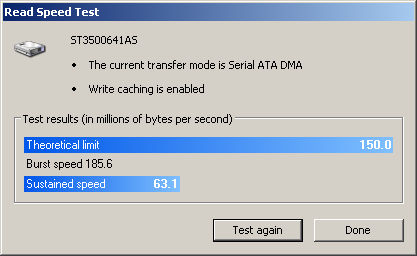
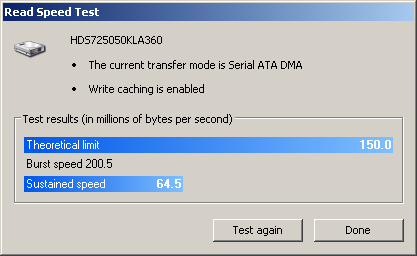
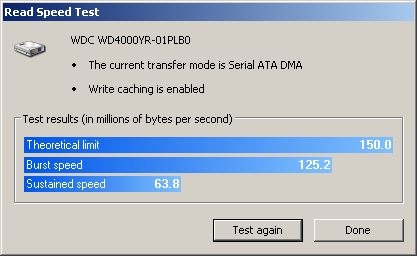
It seems the Windows Read Speed Test gives us a better readout of the actual transfer rates of each drive. We see that the Seagate and Hitachi read speeds are off the charts because of their 3.0Gb/sec maximum transfer rate. The WD4000YR is a 1.5Gb/sec drive which is why the transfer rate is much lower than the 7K500's 200MB/sec+ rate.


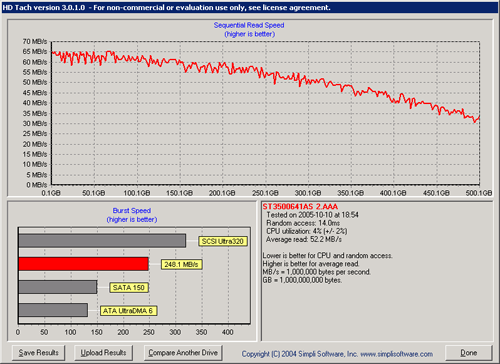
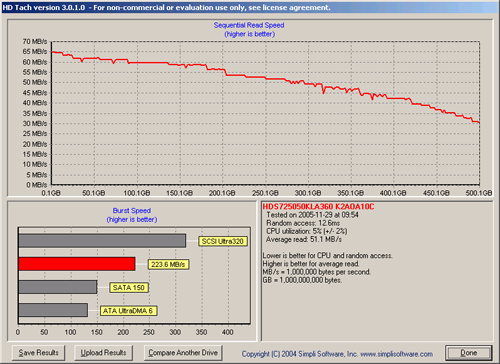
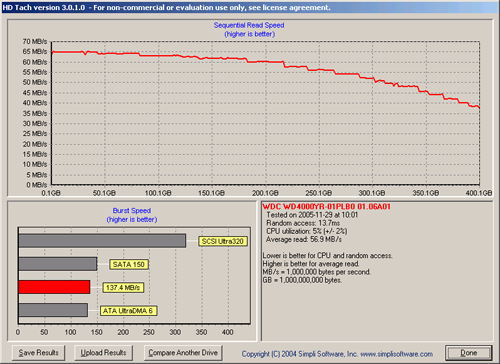








46 Comments
View All Comments
Griswold - Friday, December 2, 2005 - link
I can understand mentioning AGP, but PCI? You gotta be kidding me... that bus is such a bottleneck. You dont even have to run PCI cards to find out, just stress all the on-board stuff on a feature rich mobo and you'll notice it too.
Cygni - Friday, December 2, 2005 - link
Which explains the rush from the mfts to get PCI-Ex cards out the door. :p Really, the only 2 cards that i can see benifiting from the PCI Express bus are high level RAID cards and gigabit ethernet... both of which are being fully integrated into southbridges anyway.Hikari - Friday, December 2, 2005 - link
You said AGP and PCI, not AGP and PCIe. Obviously there isn't a lot of difference between the latter, but there is quite a bit of difference between the former.Griswold - Friday, December 2, 2005 - link
They are integrated into southbridge and still utilize the PCI bus mostly. PCI bus aint only the slot you see on your mobo, you know..Anton74 - Friday, December 2, 2005 - link
High level RAID? A single PATA drive has an interface speed identical to that of the PCI bus (133MB/s) these days, all by itself. And then there's SATA with 150MB/s and 300MB/s interface speeds now. Not to mention the PCI bus is usually shared with a multitude of devices, all wanting some bandwidth.puffpio - Friday, December 2, 2005 - link
It seems anomalous that the Western Digital Raptor 10000RPM drive is sooo much slower in the Doom 3 level load test compared to all the other drives. It sticks out like a sore thumb. It doesn't make sense because it had been dominating the other tests...